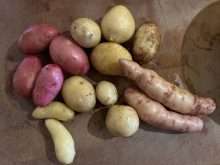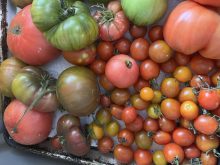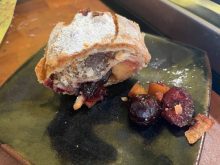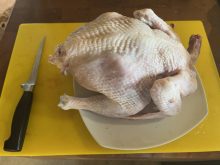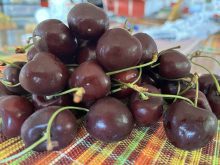One way to gauge the importance of something in culture is to look at the word’s use in everyday language.
When it comes to salt, we have many linguistic idioms and turns of phrase. Salt of the earth. Salty old dog. Salty language. Rubbing salt in a wound. Taking things with a grain of salt. Be worth your salt. Toil in the salt mines. Being seated above or below the salt. Salting away money. Sharing salt. A covenant of salt. Throwing salt on someone’s game. Knowing something so well that it’s hung up and salted.
Another measurement is what’s been written about the subject. In my own curious cook’s library, I have a wide range of facts, history, methods, mindsets and recipes pertaining to salt: Mark Kurlansky’s Salt: A World History; Sandor Katz’s The Art of Fermentation; Salt Fat Acid Heat by Samin Nosrat; scientist Harold McGee’s On Food and Cooking; Charcuterie by Michael Ruhlman and Brian Polcyn; Batch by Joel MacCharles and Dana Harrison; and most recently, The Miracle of Salt: Recipes and Techniques to Preserve, Ferment and Transform Your Food by Naomi Duguid, published in 2022.
Read Also

Gentle treatments for pain in the neck
Heading toward year-end, people unknowingly tense up against the cold and busyness, causing neck pain that can often be treated with appropriate support and gentle mobility, athletic therapist Kathlyn Hossack says.
Duguid is also a curious cook, traveller and photographer who has written some amazing and visually stunning books, alone and with her former partner, Jeffrey Alford. Check out Beyond the Great Wall; Hot Sour Salty Sweet; Flatbreads & Flavors; and Seductions of Rice, among others.
The Miracle of Salt is chockablock with recipes I can’t wait to try. Duguid draws on new trips and old to present salt’s history, usage, extraction methods and recipes that, as the subtitle says, preserve, ferment and transform food.

You can reinvent your cooking or simply expand your range, depending on how far into the salt tunnel you want to venture. And it is a salty tunnel, a rabbit hole of information that digs deep, from types of salt to condiments and flavourings to ingredient profiles (miso, salted anchovies, salt cod, etc.).
The book offers in-depth origin stories as well as recipes and step-by-step how-tos and whys, plus many gorgeous photos, some by the author, most by Richard Jung.
Salt-preserved lemons in the Moroccan style will add authenticity to your tagines, and spiced green mango pickle is a fine counterpoint to South Asian curries. Two types of kimchi give a choice of flavour complexities and heat quotient.
Make-your-own miso and koji are intriguing, as is basturma, an Armenian bresoala-like cured beef. Small-batch sauerkraut puts many Northern European dishes based on this fermented classic within your grasp.
Over my years in the kitchen, I have used two methods Duguid explains. One is brines (for pickles, corned beef and before roasting meat or poultry) and the other is dry-curing for pork (to make bacon), duck (for duck prosciutto) and fish (to make gravlax).

But at this point in my kitchen life, I am more interested in the fish- and vegetable-based “salt condiments” Duguid presents as flavour agents to elevate my cooking than in mastering slow-moving meat preservation techniques of curing and drying that fed us globally for millennia before refrigeration. (See my past Grainews columns on corned beef, on herbes sélees, and on preserved lemons although I would now double the salt in the lemons…)
If you want to up your game by creating a “salt larder” of flavour agents, plenty of standout recipes here will support your learning. To undertake the painstaking process of brined, salt-cured and air-cured meats, Duguid is a good guide.
She offers histories, details, photos, facts and the necessary exactitude for safety. Making jerky, corned beef or duck breast prosciutto are good entries into these arcane doings that are beloved by chefs.
This book is a keeper. So much to learn! First we eat, then we read those sections on salt mines around the world.
Duck Breast Prosciutto
This duck breast prosciutto can be served on a charcuterie platter, in salad, as a pasta garnish or on crackers or toast. Store unused portion wrapped in cheesecloth in the fridge for up to 30 days. Makes one.
- 400 grams whole boneless duck breast, skin on
- 12 grams kosher or fine sea salt
- 1 gram curing salt #1 (“pink” salt, available at good butcher shops)
- 4 grams brown sugar
- 1–2 grams ground ginger
Lay the duck breast on a plate, mix together the dry ingredients and rub the mixture over the entire surface of the breast. Put breast and its rub into a plastic bag, press out air and seal. Cure in the fridge for five to seven days, turning it every day, just like making bacon.
Remove breast from bag and rinse well. Pat dry and wrap in two layers of cheesecloth. Label with date and weight in grams. Tie securely with kitchen string, making a loop. Hang in a cool, airy place (10 C or 50 F), or place on a rack over a tray in the fridge for eight to 10 days, turning it daily, until it loses 30 per cent of its original weight.
To serve, unwrap and slice thinly against the grain.




